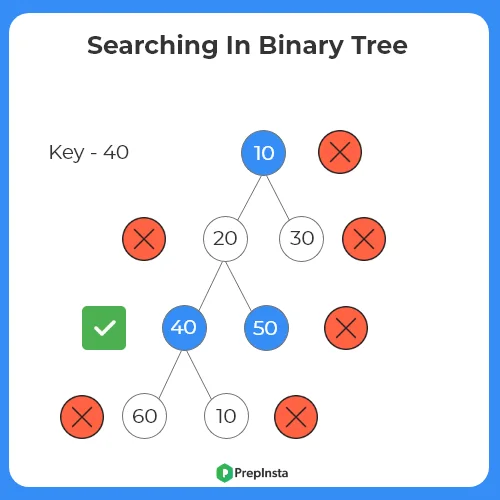0
Notifications Mark All Read
- Login
- Get Prime
Searching In A Binary Tree In C++
Searching In A Binary Tree
Given a tree and the number, we need to find to check whether the number is present in the binary tree or not. There can be different ways to approach this problem. In this articles, two ways are discussed, level order and recursion.

Algorithm Using Level Order Traversal:
- Initialize the queue.
- Add root to the queue.
- Until the queue is empty, add the left child and the right child of the current node.
- Pop the node.
- Traverse the queue, check whether key is equal to the value of node.
- If found return true otherwise false.


Algorithm Using Recursion:
- If root is null, return.
- Else Recursively check for the left subtree and the right subtree.
- Return true if found.
Code (Level Order):
#include<bits/stdc++.h>
using namespace std;
class Tree {
public:
int data;
Tree* left = NULL,*right = NULL;
// Constructor initialised
Tree(int x) {
data = x;
left = NULL;
right = NULL;
}
};
// To check whether equal or not
bool check(int key,int element) {
if (key == element) return true;
return false;
}
void level_order(Tree *root, int key) {
if (root == NULL) return;
queue q, lev;
q.push(root);
// Getting Level Order
while (!q.empty()) {
Tree * temp = q.front();
lev.push(temp);
// Adding left child
if (temp -> left != NULL) {
q.push(temp -> left);
}
// Adding Right child
if (temp -> right != NULL) {
q.push(temp -> right);
}
q.pop();
}
bool ok = false;
while (!lev.empty()) {
if (check(lev.front() -> data,key)) {
cout << “Found\n“;
ok = true;
}
lev.pop();
}
// If not found
if (!ok) {
cout <<“Not Found”;
}
}
int main() {
Tree *root = new Tree(10);
root -> left = new Tree(20);
root -> right = new Tree(30);
root -> left -> left = new Tree(40);
root -> left -> right = new Tree(50);
level_order(root,40);
return 0;
}
Output:
Found
Code (Recursion):
#include<bits/stdc++.h>
using namespace std;
class Tree {
public:
int data;
Tree* left = NULL,*right = NULL;
// Constructor initialised
Tree(int x) {
data = x;
left = NULL;
right = NULL;
}
};
// To check whether equal or not
bool check_element(Tree * root, int key) {
// If root is null, element is not found:Backtrack
if (root == NULL) {
return false;
}
// Check whether same or not
if (root -> data == key) {
return true;
}
// Recursively call for left and right subtree
return (check_element(root -> left, key) || check_element(root -> right, key));
}
int main() {
Tree *root = new Tree(10);
root -> left = new Tree(20);
root -> right = new Tree(30);
root -> left -> left = new Tree(40);
root -> left -> right = new Tree(50);
if (check_element(root,45)) {
cout << “Found\n“;
}
else {
cout << “Not Found\n“;
}
return 0;
}
Output:
Not Found
Time Complexity For Searching Element In A Tree
Time Complexity
O(n) Queue and Recursion
Space Complexity
O(1) Queue and Recursion

 0
0
Login/Signup to comment